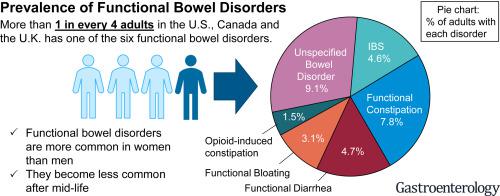当前位置:
X-MOL 学术
›
Gastroenterology
›
论文详情
Our official English website, www.x-mol.net, welcomes your
feedback! (Note: you will need to create a separate account there.)
Prevalence of Rome IV Functional Bowel Disorders Among Adults in the United States, Canada, and the United Kingdom.
Gastroenterology ( IF 25.7 ) Pub Date : 2020-01-07 , DOI: 10.1053/j.gastro.2019.12.021 Olafur S Palsson 1 , William Whitehead 1 , Hans Törnblom 2 , Ami D Sperber 3 , Magnus Simren 4
Gastroenterology ( IF 25.7 ) Pub Date : 2020-01-07 , DOI: 10.1053/j.gastro.2019.12.021 Olafur S Palsson 1 , William Whitehead 1 , Hans Törnblom 2 , Ami D Sperber 3 , Magnus Simren 4
Affiliation

|
BACKGROUND & AIMS
Little is known about the population prevalence or demographic distributions of Rome IV functional bowel disorders (FBDs) or their effects on quality of life. We examined these in a multi-national survey.
METHODS
We analyzed data from a population-based survey of adults in the United States, Canada, and United Kingdom (5931 valid responders; 49.2% female; mean age, 47.4 years; range, 18-92 years). The survey included the Rome IV Diagnostic Questionnaire, Rome III irritable bowel syndrome (IBS) and constipation questions, and the SF-8 quality of life questionnaire.
RESULTS
The prevalence values of census-adjusted Rome IV FBDs were similar among the 3 countries; ranges were: 4.4%-4.8% for IBS, 7.9%-8.6% for functional constipation, 3.6%-5.3% for functional diarrhea, 2.0%-3.9% for functional bloating or distention, 1.1%-1.9% for opioid-induced constipation, 7.5%-10.0% for unspecified FBDs, and 28.6%-31.7% for any Rome IV FBD. FBDs were less common in older individuals, and all except functional diarrhea were more common in women. IBS was only half as prevalent by Rome IV as by Rome III criteria (4.6% vs 9.0% overall), primarily due to higher Rome IV minimum pain frequency. Functional diarrhea and functional constipation were more prevalent by Rome IV than Rome III criteria. Subjects with FBD had significant reductions in quality of life and reported more gastrointestinal doctor consultations than other subjects.
CONCLUSIONS
More than one in four adults in the general population meet the Rome IV criteria for FBDs. These disorders affect quality of life and increase use of gastrointestinal healthcare. The switch from Rome III to Rome IV criteria reduces the prevalence of IBS by half, but increases the prevalence of functional constipation and functional diarrhea.
中文翻译:

美国,加拿大和英国成年人中罗马IV型功能性肠病的患病率。
背景与目的关于罗马四世功能性肠病(FBD)的人群患病率或人口分布及其对生活质量的影响知之甚少。我们在多国调查中检查了这些。方法我们分析了在美国,加拿大和英国(5931名有效应答者; 49.2%的女性;平均年龄47.4岁;年龄范围18-92岁)的成年人群调查数据。该调查包括罗马IV诊断问卷,罗马III肠易激综合症(IBS)和便秘问题,以及SF-8生活质量问卷。结果在这三个国家中,经普查调整的罗马四代生物多样性公约的患病率相似。范围为:IBS为4.4%-4.8%,功能性便秘为7.9%-8.6%,功能性腹泻为3.6%-5.3%,功能性腹胀或扩张为2.0%-3.9%,1.1%-1。阿片类药物引起的便秘为9%,未指定的FBD为7.5%-10.0%,任何罗马IV FBD为28.6%-31.7%。FBD在老年个体中较不常见,除功能性腹泻外,所有其他疾病在女性中均较常见。罗马四世的IBS仅为罗马三世标准的一半(4.6%比9.0%的总体水平),这主要是由于罗马四世的最低疼痛频率更高。罗马四世时期的功能性腹泻和功能性便秘比罗马三世时期的标准更为普遍。患有FBD的受试者的生活质量显着下降,并且与其他受试者相比,报告了更多的胃肠道医生咨询。结论在普通人群中,有超过四分之一的成年人符合罗马IV有关FBD的标准。这些疾病影响生活质量并增加胃肠保健的使用。
更新日期:2020-04-21
中文翻译:

美国,加拿大和英国成年人中罗马IV型功能性肠病的患病率。
背景与目的关于罗马四世功能性肠病(FBD)的人群患病率或人口分布及其对生活质量的影响知之甚少。我们在多国调查中检查了这些。方法我们分析了在美国,加拿大和英国(5931名有效应答者; 49.2%的女性;平均年龄47.4岁;年龄范围18-92岁)的成年人群调查数据。该调查包括罗马IV诊断问卷,罗马III肠易激综合症(IBS)和便秘问题,以及SF-8生活质量问卷。结果在这三个国家中,经普查调整的罗马四代生物多样性公约的患病率相似。范围为:IBS为4.4%-4.8%,功能性便秘为7.9%-8.6%,功能性腹泻为3.6%-5.3%,功能性腹胀或扩张为2.0%-3.9%,1.1%-1。阿片类药物引起的便秘为9%,未指定的FBD为7.5%-10.0%,任何罗马IV FBD为28.6%-31.7%。FBD在老年个体中较不常见,除功能性腹泻外,所有其他疾病在女性中均较常见。罗马四世的IBS仅为罗马三世标准的一半(4.6%比9.0%的总体水平),这主要是由于罗马四世的最低疼痛频率更高。罗马四世时期的功能性腹泻和功能性便秘比罗马三世时期的标准更为普遍。患有FBD的受试者的生活质量显着下降,并且与其他受试者相比,报告了更多的胃肠道医生咨询。结论在普通人群中,有超过四分之一的成年人符合罗马IV有关FBD的标准。这些疾病影响生活质量并增加胃肠保健的使用。











































 京公网安备 11010802027423号
京公网安备 11010802027423号